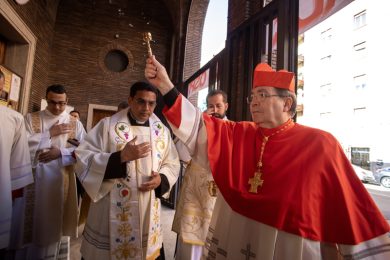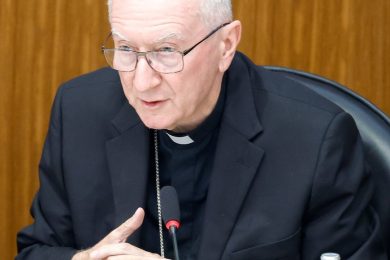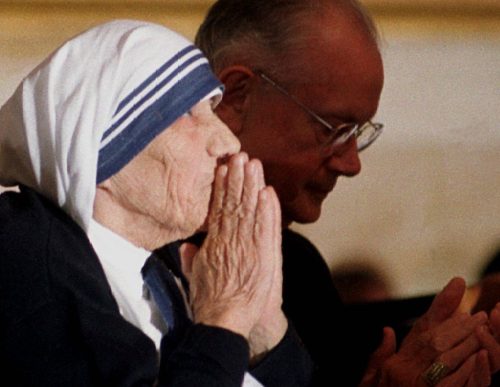By Amy Welborn | OSV News
No modern figure has been more revered as a saint in life, so the rapid progress of Mother Teresa’s cause from her death to her canonization within two decades came as no surprise.

From the day Mother Teresa rode on a train in India in 1946 and heard Jesus Christ tell her, “Come be My light,” her life was a steady answer to that call until her death Sept. 5, 1997. Pope Francis canonized her in 2016. With her Sept. 5 feast day, the church honors St. Teresa of Kolkata for committing herself to bring the light of God’s love to the poorest of the poor.
Her response has borne great fruit, as we can see from the continued ministry of the Missionaries of Charity with the dying, the destitute, the orphans and the rejected. But Mother Teresa would not want our reflections on her life to stop with appreciation of what others have done in her name. As she said many times, God desires to work through each one of us. When we reflect on her life, we are really seeing how any of us — if we allow God to fill our hearts and guide us — can change the world, one life at a time.
She was born Agnes Bojaxhiu Aug. 27, 1910, in Yugoslavia, of Albanian parents. In 1928, she joined the Sisters of Loretto and traveled to Ireland for formation. Soon after, she was sent to India to teach in her order’s school for girls in Calcutta (officially renamed Kolkata in 2001, four years after her death).
In 1946, then-Sister Teresa was traveling to a retreat when she experienced a “call within a call” from God to follow him in a new direction. “The mission was quite clear,” she later told a biographer. “It was an order. I was to leave the convent. I felt God wanted something more from me. He wanted me to be poor and to love him in the distressing disguise of the poorest of the poor.”
Sister Teresa became Mother Teresa, foundress of a new religious order, the Missionaries of Charity. Teresa left her old motherhouse with only a few coins in her pocket, began dressing in traditional Indian attire — a white sari with a blue border — and moved to the poorest section of Calcutta. She obtained some basic medical training and opened a school. Within a year, she had been joined by several of her former students, and in time, they embraced the ministry for which they are most well known today: the care of the dying.
At the time of her death, the Missionaries of Charity ministered to the poor throughout the world, from Calcutta to Baghdad to New York City. They continue to touch the lives of thousands with the love of Jesus, bringing his light to those whom the world would like to forget.
Her ministry to the dying and destitute was tremendously difficult on many levels. The people whom the sisters brought in from the streets were suffering physically, emotionally and spiritually. Why bother with them? Because God called her to do that. How could she continue with joy? Through the presence of Jesus, especially in the Eucharist.
In the Gospel of Matthew, Jesus tells us that when we meet those in need, we meet him, and that when we serve those in need, we serve him. Mother Teresa is a living witness to the truth of Jesus’ words, and to their power. The Christ she met in the Eucharist each day revealed to her his presence in the poor.
Mother Teresa also reminds us that if Christ is present in the poor, we have much to learn from them. They teach us about human dignity, patience and wisdom. It is, as Mother Teresa said, a privilege to live with and serve the poor.
It is tempting to turn away from the difficulty of suffering, to let someone else handle it, to hope it will go away. Sometimes we are even tempted to take pleasure in the suffering of others or, at the very least, rest complacently in our belief that suffering was unavoidable or even deserved.
But when we listen to Jesus, when we see how Mother Teresa put flesh onto his words and what joy it brought to the suffering, even if for only the brief moments before they passed from this life, how can we continue to think this way?
By the 1970s, Mother Teresa was famous. Books had been written about her, documentary films had been made about her, and she had received numerous important awards. We live in an age of celebrity, and perhaps some think that Mother Teresa’s importance lay in her fame, or in the big things she had done, because today, that is what we value: huge achievements, powerful institutions and a wealth of attention.
But Mother Teresa’s life and message always stood in complete opposition to this modern sensibility. From the day she took the first dying person into her room in Calcutta, she was a witness to the importance of the small gesture and simple acts of care, performed with great love.

In a world that values productivity, health and usefulness, Mother Teresa’s care for the dying seems kindly, but of doubtful use, perhaps even a “waste.” But that is the way the world sees it. Through the eyes of Mother Teresa, each dying person is a precious child of God in need of love, no matter how close death might loom.
Cleansing a wound, sharing food, pushing a wheelchair, or simply being present to another: acts that will not inspire headlines or make a profit, but small acts that are precious because they are “something beautiful for God.”
The suffering that Mother Teresa and her sisters have dealt with is extreme. Over the years, many have traveled to Kolkata to serve with the Missionaries of Charity, doing valuable work and building up other foundations and ministries of the order around the world.
Mother Teresa, however, always made it clear that there is no need for any of us to travel across the globe to follow Jesus. She said, “You can find Calcutta all over the world, if you have eyes to see. Everywhere, wherever you go, you find people who are unwanted, unloved, uncared for, just rejected by the society — completely forgotten, completely left alone. That is the greatest poverty of the rich countries.”
There are many kinds of hunger besides physical hunger, Mother Teresa constantly reminds us. Even those who are well fed suffer from loneliness and hurt. There are many kinds of suffering — physical and spiritual — and many kinds of darkness. This is where the love of Christ can shed light, and why Mother Teresa said, “Do ordinary things with extraordinary love.”























Pour forth, we beseech thee, oh Lord, thy grace in our hearts, that we, to whom the incarnation of Christ your Son, was made known by the message of an angel, may by His passion and cross be brought to the glory of His resurection, through the same Christ our Lord. Amen
When I was a child at St. Paul Parish in Sauk Centre, Monsignor Michael Kraemer would say this prayer at every Sunday Mass before the homily. Is this prayer still prayed on our churches?